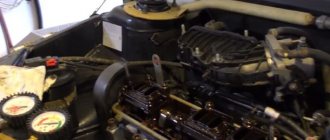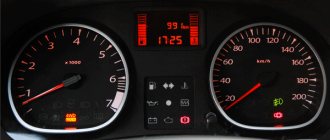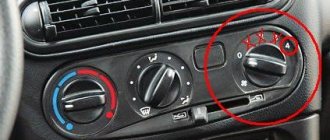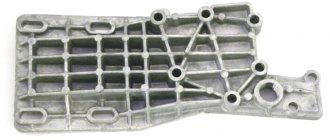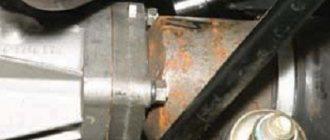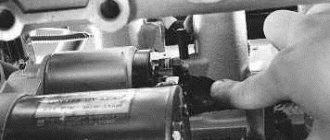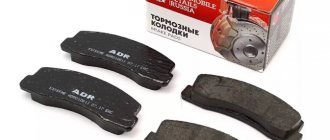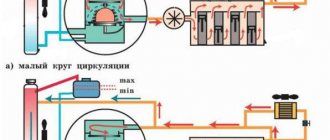How to engage reverse gear in the field
I think it’s time to talk about the transfer case of the Chevy Niva, because those who just bought this car, at the very beginning of use, do not really know how to use the transfer case, what the rules are, and in general, when to lower the gear and when to lock it.
Let's figure it out now. It’s a pity, of course, that I didn’t record a video on today’s drive along a fairly washed-out road. Well, never mind, I’ll record it and show it clearly on video. For now, in words. In general, the transfer case switches to a lower gear, as well as to lock, and it is possible and even necessary to do this at the same time. It’s convenient on the Shevik - this is done with one lever.
Turn it down - right up. Add lock - Pull the lever all the way to the left. Look at the switch handle, it's written there. Letter designation - L (low) - low, N - neutral, H (high) - high, that is, normal.
How inter-axle locking works - read this article. There you will also learn about self-blocks - a real cool upgrade for the Chevrolet Niva, which will allow you to drive even further.
Well, now we’ll figure out when it’s better to turn it down, and when to also lock it. And how to do it correctly.
It looks something like this - we are driving across the field in normal second/third gear. Suddenly there is a terrible puddle ahead. We stop and turn down the car.
This is the first rule - when you engage the lower gear, you must definitely stop, that’s how the Shevik differential is designed. But the lock can be turned on and off without stopping. But do you need to always enable the blocking? It’s an interesting question and I’ll tell you what - I use it in exceptional cases, when the dirt is not out of the blue, but there are all sorts of potholes and where there is a risk of catching the “diagonal”.
You may ask - how long does it take to turn on the blocking and then turn it off? There is another nuance here - very often, many owners of the Chevrolet Niva have a problem with the blocking - it does not turn off. It just jams and that’s it, you have to drive on the highway with the blockage. This, you understand, is very harmful for the machine and in such cases you must turn it off.
How to turn off the interaxle? There are several options - turn on reverse, accelerate a little and try to dislodge the lock while driving. You need to do this at speed; it works quite often. Moreover, you can accelerate forward and also try to turn off the lock. I also got stuck once, but even then I didn’t notice it right away and it’s not a problem. Therefore, look at the on-board computer - when the lock is turned on, the following combination will “burn”:
In bright sunny weather it is sometimes difficult to see. Be careful. Well, about turning off the center wheel - I managed to turn it off just when reversing. Needless to say, now I turn it on only in the most dire cases. In the rest of the others, lower gears are quite enough for me.
Just today I went to the lake to check if the ice had melted. The road was washed out, the snow had already melted and turned into liquid mud, and it’s not safe to drive through such mud on my AT tires. It feels like it’s being dragged in all directions, but the most important thing is that I’m driving, I don’t get stuck, and sometimes the ruts were almost to the very bottom; when you shuffle, it always becomes unpleasant)) After some short drives, the car looked “military-like” - all covered in mud , went to the city - people look around))
And here’s another observation of mine: it’s better to drive through mud slowly but surely. This applies to lower gears - if the mud is serious, then I always drive in first, pushing hard, trying to feel the wheels spinning in the mud. If you accelerate a little, you can immediately “burrow”, this is the case when there is no hard covering under the liquid mud. This happens when driving through spring fields. That’s why it’s better to do it slowly, at first. Operate the pedal, don’t accelerate, feel how the car is really “rushing” - at first it feels great.
Well, a lot, of course, depends on the tires. Sometimes, if the tires are toothy, it is useful to accelerate so that the tread cleans itself. For Nivka and Shevik I highly recommend Cordiant Offroad tires, and if you have a little more money, then imported ones - Kumho and of course Hankuk Dinapro MT. Imported tires are more comfortable and are better for driving on the highway because they are soft. Well, in terms of cross-country ability, everything is also very cool here - after all, the tires are a Mud Terrain class, which means they are simply designed for mud.
When you turn on the second lower gear, the car accelerates, but if you get into a mud hole, there is a risk that the engine will “choke” (it is very difficult to spin the wheels in the second gear when stuck) and you will stall. Needless to say, stalling in a deep puddle can be dangerous. Therefore, if you decide to overcome a puddle or muddy area with acceleration (very often this makes sense), then be prepared in the middle, if you suddenly start to fall through, immediately switch from 2 to 1 low, so as not to stall.
Possible problems
Quite often, car owners do not know how to use the transfer case on a Niva, and may encounter the fact that the center lock does not turn off, and they have to drive along the highway in this mode, which negatively affects the car. In order to switch the transmission to normal mode, you need to switch to reverse gear and accelerate a little, and while reversing, try to dislodge the lock. If this doesn't work, you can try to do the same thing, only while moving forward.
To avoid transmission problems, Niva car owners must adhere to the following rules:
- Try not to change gears while slipping;
- If the lock switches with difficulty, there is no need to apply excessive force;
- When a difficult-to-pass section has been overcome, it is necessary to unlock it again, since on a flat road in this mode at high speeds the car’s controllability deteriorates, and the service life of the entire transmission decreases.
Here are the basic rules by following which you can significantly extend the life of the gearbox on a Chevrolet Niva.
| The car is equipped with a five-speed gearbox, a transfer case with a range and a locking center differential. |
| Operate the gearbox according to the shift diagram marked on the handle of its lever. |
| Figure 1.15. Transmission lever shift diagrams: 1 – gear shift lever; 2 – transfer case control lever Recommended maximum vehicle speeds, km/h
|
Overcoming fords and puddles
After long-term operation of the vehicle in water, it is necessary to check the penetration of water into the crankcases of the front and rear axles, and if necessary, change the oil.
Warning. Exercise special attention and caution in the first minutes after the rain begins, as moistened dust on the road surface forms a slippery film, which sharply reduces the grip of the tires on the road.
Regularly while driving, lightly slow down the car to dry the brakes, as the effectiveness of wet brakes decreases sharply.
When overtaking, turn the windshield wiper to maximum mode - this will help avoid loss of visibility due to the possible release of water from under the wheels of the vehicle being overtaken. It is advisable to apply such precautions even if you are overtaken.
Do not overtake in rainy weather if a cloud of water from under the wheels of the car in front completely blocks your view of the overtaking area.
To avoid driving in the plume of water from cars in front, increase your distance and reduce your speed.
Tips for owners
To make driving your car comfortable, read some important points:
- The usual, standard arrangement of the front and rear handles is forward and backward, respectively. Movement in this mode can and should be carried out in areas characterized by even and smooth surfaces.
- Locking the differential by switching the front handle to the rear position is best on roads characterized by increased slipperiness. This measure will give Niva stability. It is worth understanding that after overcoming the problem area, the handle will need to be returned to its original position.
- As noted earlier, downshift should be activated before a potential obstacle, but not while the car is already stuck.
- It is worth understanding that activating the lock when the vehicle is stationary is sometimes impossible, even if the clutch is depressed. This may be caused by the clutch teeth hitting the gear teeth. In this case, you can try to activate the lock by starting to drive slowly and make a slight turn. If problems arise with disabling the lock, it is recommended to perform the same procedure with the clutch depressed and the steering wheel slightly rocked.
Also interesting: How does the transfer case work on a Chevrolet Niva?
see also
Comments 14
First of all, we remove the spring due to which the gearshift lever needs to be pressed down (well, unless, of course, you are an adequate driver and do not try to engage the rear when the car is moving forward). Then turn on the rear by lightly pressing on the fifth
Wait a minute to clean up. I just learned to crunch)
In general, as they said here, there will be a crunch if you immediately engage the rear from neutral. Never thought about it. Usually I’ll squeeze it out, think about it, and turn it on. Moreover, I noticed more: first you need to accelerate in neutral (like coasting, too), and then immediately after squeezing, engage reverse gear.
I tried it myself and it’s crunchy too. But I usually either turn it on after moving forward (i.e. from the first) or with a delay
Read more: How to change running lights on Kalina 2
Source
We help with all our wheels
How to enable all-wheel drive on a Chevrolet Niva? You can block the center differential of the Chevy Niva both when the car is stationary and while driving.
This is done with the clutch pedal depressed using the transfer case control lever, which is located behind the large gear selector. When the lever is in the neutral position, you need to pull it towards the driver. If you then press in the opposite direction, a lower gear will be engaged with a center differential lock and a gear ratio of 2.1. If you pull it towards you, a lower gear is activated (gear ratio 1.2).
When the lever is in this position, the corresponding yellow pictogram lights up on the dashboard. If you cannot follow these instructions, try repeating the procedure while driving the vehicle.
The correct sequence for engaging the rollover lock is given in the owner's manual for that vehicle. It states that such blocking must be carried out in advance, while the car is moving along a section of the road with a hard surface. The action must be performed when changing the steering wheel position. To prevent breakdowns and damage to differential parts, blocking is prohibited during slipping or when the wheels (wheels) are sliding. The mode is switched using the same lever.
If the lock does not turn on using the specified method, do not use excessive force. Just repeat the entire sequence of actions from the beginning.
Switching to a lower gear is also allowed without stopping the Niva completely, but this can only be done by experienced drivers. The fact is that the transfer case, unlike the gearbox, does not have synchronizers installed. Changing from a lower gear to a higher gear while the car is moving is undesirable, although it is allowed in extreme cases.
It is not recommended to keep the center differential of the wheels in locked mode at all times, especially when driving on asphalt roads, as this will not only lead to increased fuel consumption by the vehicle and poor handling, but also to the breakdown of expensive transmission components.
How to engage reverse gear in the field
TRANSFER CASE SHIFTING
Transfer case levers and their positions
The gear shift lever in the transfer case can occupy the following positions:
H - low gear;
N - neutral position;
B - top gear.
The differential lock lever in the transfer case can occupy the following positions:
P - differential unlocked;
B - differential is locked. When the lever is moved to this position, a warning light comes on in the instrument cluster, warning that the differential is locked.
NOTE Shifting from low to high gears and locking the differential can be done while driving with the clutch disengaged.
It is recommended to engage low gear in the transfer case after the vehicle has come to a complete stop and with the engine disconnected from the transmission.
To overcome difficult sections of the road, block the differential in advance. Do not lock the differential when the car's wheels are slipping. After overcoming such sections, unlock the differential - driving the car on good roads with a locked differential shortens the life of the power transmission mechanisms, increases tire wear and fuel consumption, and when braking the car can lead to skidding.
SHIFTING TRANSMISSION GEARS
Gear shift diagram (also printed on the handle)
Before driving, check the position of the transfer case levers - it must correspond to the road conditions. Start driving in first gear and, as the crankshaft speed increases, move to higher gears in a timely manner.
In time and in accordance with the road situation, change to a lower gear in the gearbox, avoiding overloading the engine.
To move in reverse, press the gear shift lever, pushing it all the way down and move it to the position corresponding to engaging reverse gear. Engage reverse gear only when the car is completely stopped.
Video
Gear shift diagram
Before driving, check the position of the transfer case levers - the gear shift lever should be in the “high gear” position, and the differential lock lever should be in the “unlocked” position.
Start driving the car in first gear and, as the crankshaft speed increases, move to higher gears in a timely manner.
At very low ambient temperatures and after the car has been parked for a long time, it is recommended to drive at least 1 km in first gear with the differential lock engaged and the lowest gear in the transfer case. In this case, the engine must operate at an average crankshaft speed so that the oil in the gearbox, transfer case, front and rear axles warms up and becomes less viscous, which is necessary for normal lubrication of the gears.
To move in reverse, press the gear shift lever, pushing it all the way down and move it to the position corresponding to engaging reverse gear. Engage reverse gear only when the car is completely stopped.
To overcome steep climbs, when driving on soft soils, and also to obtain a minimum stable speed on paved roads, first engage a low gear in the transfer case. It is recommended to engage low gear in the transfer case after the vehicle has come to a complete stop.
To overcome difficult sections of the road, block the differential in advance. Do not block the differential when both wheels of one of the vehicle's drive axles are slipping. After overcoming such sections, unlock the differential - driving the car on good roads with a locked differential shortens the life of the power transmission mechanisms, increases tire wear and fuel consumption, and when braking the car can lead to skidding. If unlocking the differential is difficult while driving, do it with the car stopped.
Shifting from low to high gear and locking the differential can be done while the vehicle is moving.
After overcoming fords, as well as after washing the car or when driving for a long time on a wet road, when water gets into the brake mechanisms of the wheels, brake the car several times while driving to dry the discs, drums and brake linings.
Whenever possible, drive at moderate, constant speeds. Sharp accelerations and decelerations, driving the car at high speeds lead to excessive consumption of gasoline. In addition, excessive consumption of gasoline is also caused by insufficient air pressure in the tires, worn or dirty spark plugs, and the use of engine oils with a higher viscosity than recommended.
While driving, monitor the operation of various systems using the appropriate instruments and warning lamps. Under normal conditions, the red light lamps should not light up - their inclusion signals the need to check the corresponding system.
VAZ-21213 (Niva). Adjusting the ignition timing
Adjusting the ignition timing
2 – octane corrector scale;
3 – nut When operating a car, sometimes, depending on the quality of the fuel being filled, it becomes necessary to adjust the ignition timing.
The ignition timing is adjusted by octane corrector 2 (see Fig. Adjusting the ignition timing) of the ignition distributor, which allows you to reduce or increase the ignition timing. The “+” (advance) and “–” (lag) signs printed on the octane corrector scale indicate the direction of its rotation.
1. Before adjustment, mark the position of the middle mark of the octane corrector on the cylinder block. 2. Make adjustments on a warm engine. 3. To do this, when driving on a flat road in fourth gear at a speed of 50 km/h, sharply press the accelerator pedal. 4. If a slight and short-term detonation occurs, then the ignition timing is set correctly. 5. In case of strong detonation (early ignition), loosen nut 3 and turn housing 1 of the distributor sensor 0.5–1 division clockwise (to “–”). 6. If there is no detonation (late ignition), turn housing 1 by 0.5–1 divisions counterclockwise (to “+”). 7. After adjustment, tighten nut 3 and check the correct ignition timing when driving.
VAZ-21213 (Niva). Braking and parking
The brake design ensures effective braking. However, try to brake smoothly and moderately in all cases, avoiding sudden braking.
Do not turn off the ignition or remove the key from the ignition switch while the vehicle is moving. When the engine stops, the vacuum necessary for the operation of the vacuum booster is not created, and as a result, the force that must be applied to the brake pedal to brake the car increases. In addition, when the key is removed, the steering shaft is blocked by an anti-theft device and the car becomes uncontrollable.
If one of the circuits of the brake system fails, the second circuit provides braking of the vehicle. At the same time, the brake pedal travel increases and braking efficiency decreases, which at first can be assessed by you as a complete brake failure. In this case, do not release the pedal and do not press repeatedly, which only increases the braking distance, but press the pedal until you obtain the maximum possible braking effect.
How to use?
By switching the operating modes of the transfer case, you can adjust the behavior of the car in accordance with road conditions.
Low gear is used in two cases:
- It is necessary to ensure low speed. For example, if you need to drive onto a curb or other obstacle, you can engage a lower gear so as not to burn the clutch.
- Need high torque. A lower gear is engaged before overcoming steep inclines.
The differential lock is activated when driving off-road, where there is a high risk of slipping.
At the same time, it must be turned on before entering a difficult area.
In general, you need to use the transfer case like this:
- Driving on the highway. The differential is unlocked, the first speed of the RK is turned on.
- Overcoming climbs and obstacles on hard surfaces. The differential is unlocked and the reduced speed is engaged.
- Overcoming difficult snowy areas, mud, slippery climbs. Locking and reduced speed enabled.
How to turn on reverse in a field
Car repair and tuning
Everyone knows that in a car, a mechanical differential with manual or automatic gear shifting is used to connect the power unit with the chassis and change the traction force on the wheels.
A gearbox is a complex transmission mechanism for mobile vehicles, designed to expand the range of rotation speed and torque transmitted from the engine, the possibility of short-term or long-term disconnection of the internal combustion engine from the chassis, and regulation of the direction of movement of the vehicle.
Diagram of a 5-speed gear shift mechanism for VAZ-2123
At the factory, modern Niva cars are equipped with a five-speed gearbox , made according to the three-shaft design.
Gearbox design:
The main elements of the box body are the clutch dome, the gearbox housing itself and the rear cover. The production of frame parts is carried out at the plant from a modern aluminum alloy with chemical additives.
Heat removal from heated rubbing parts is realized by manufacturing a multi-fin structure on the surface of the crankcase and also to protect the speed selection unit from overheating and exceeding excess pressure, a breather is present in the design.
The tightness of body connections is ensured through the use of pressed shaped gaskets. In case of repair of the gear selector assembly, it is also possible to use a liquid gasket former. The lower part of the gearbox housing is covered with a stamped steel protection with a gasket.
In a modern design, the gearbox housing and synchronizer clutches are reliable and adapted to operating conditions on Russian roads.
The factory crankcase protection on the Chevrolet Niva copes with its function quite well. For safe travel on rural roads and off-road, you can consider installing additional combined protection for the gearbox and transfer case. There are many different options and designs offered on the Internet, where you can choose the option you like, both in price and in terms of configuration and quality of metal.
Over time, any mechanism wears out, sooner or later it will be necessary to carry out maintenance and adjust the gear mechanism. There are quite a lot of companies on the spare parts market that produce any components, parts and related materials for both old and new Chevrolet modifications.
Interesting! According to reviews from the owners of these cars, you can carry out maintenance and repair of the gear shift mechanism on a Chevrolet with your own hands at home.
Location of control and drainage holes:
It is equipped with a screw-on magnetic plug to collect small metal shavings. Lubrication of rubbing surfaces is carried out by spraying. Domestic oil seals are installed in the housing at the output of the primary and secondary shafts. The axis of the gearbox speed gear is fixed on the rear cover of the gearbox housing.
The rotation of the input shaft is carried out through 2 ball bearings. For the industrial shaft, the design of the unit includes double-row ball roller bearings.
A breather is installed in the upper part of the housing (near the clutch). If the breather malfunctions (cap failure), transmission oil may be squeezed out through the seals and housing connections.
The gearbox uses a three-shaft system. At the moment of turning on any of the speeds, except the fifth, the intermediate shaft transmits torque to the secondary one.
The arrangement of the shaft gears is implemented in the following sequence:
Advice! The manual transmission of the VAZ 2123 is quite “gentle”; overloads should not be allowed; it is recommended to change the oil without waiting for a mileage of 45-50 thousand km.
Design and principle of operation of the Niva 2121 transfer case
The transfer case mechanism includes more than 60 independent parts, which is confirmed by the presented drawing. Therefore, it is quite prudent to name the main elements and their purpose.
Photo No. 1
A pair of gears are tightly seated on the drive shaft, one of them (large) is intended for high gear, the second (small) is responsible for low gear. They have serrations with straight and oblique profiles. The first ones are in contact with the coupling, the second ones - with the intermediate shaft. The inclusion of one or another row causes the coupling to move along the hub in the horizontal direction, after which it is connected to the gear on the transfer case drive shaft.
The intermediate position turns off the gearbox ( the gearbox is open ), and the car cannot be moved in this mode. The front helical gear on the intermediate shaft is used to control the differential. The locking is engaged, or the rigid coupling of the drive shafts of both axles, is carried out through a clutch. The design is typical for modifications 21213 and 21214, and the latter is additionally equipped with a speed sensor drive.
- Niva Chevrolet transfer case control: device, how to turn it on and off?
Photo No. 2
In the operating state (with the transfer case reduction gear connected), the gear ratio in the first stage changes from 4.4 to 7.83, the second - from 2.52 to 4.58, the third - from 1.63 to 2.9, in the fourth - from 1.2 to 2.14, fifth - from 0.98 to 1.75, which is expressed in an increase in traction on the wheels.
Reverse gear on a Chevrolet Niva does not engage, what should I do? - Behind the wheel
As stated in the regulations, it should be changed every forty-five thousand kilometers, and before that, it is advisable to warm up the car or drive it so that it does not become completely cold and is sufficiently liquid. To make the change you need the following set of tools:
Why is the Jimny such a special car?
Aesthetically, it is a correct car with an almost exotic touch and a design that has not gone out of style. However, not everything is pink: as we mentioned earlier, this is a very small car, it has four seats and its 113 liters of luggage is a joke.
Despite everything, it is worth remembering its very competitive price. This is the ideal car that turns into a high-caliber SUV, or one that is specified for fleets.
The rest of the trim adds convenience, but you'll never be able to equip air conditioning, cruise control or satnav.
The main stages of replacing fluid on a Chevrolet Niva:
At this point, the process of replacing the fluid in the box can be considered complete.
Of course, there is no option for an automatic transmission or other motorization. Engineers modernized the old platform and added a number of standard features and a new brand identity: wide split railings. Despite the controversy, the styling continued its success, with the public captivated by the generous interior space, elevated driving position and 327-litre boot.
A high ground level works well in urban groves without compromising stability. But he wants to finish, high level of noise on the road and parts such as pedals, air leaks that let water into the cabin, trunk that can only be opened with the key and any injection and ignition locks.
How to replace the secondary shaft oil seal
If the secondary shaft of the gearbox has a leaky seal, this can lead to a decrease in the oil level. In order to carry out replacement repairs, you need:
Reverse gear is difficult to engage
Despite its specs, it's a great buy because it's hard to find a model this spacious, a little wrapped, and equipped at this price point.
In addition to convenient space for people and luggage, you can display the autopilot on the road, talk about the consumption indicated on the on-board computer, or even lean on the station to change a flashing light that has stopped working after the control panel has warned you. All this in a car that was born cheap.
Completely original headlight: 464. Original brake disc: 491. Original rear view mirror: 170. Original brake pads: 179.
The most revealing is the intermediate expression, which already has hydraulic steering, rear windshield wiper and hot air as standard equipment.
Engine mounts An easy problem to solve, usually confused by clutch wear: when the mounts rupture, they cause cramps in the cranks. A simple visual analysis will already identify the problem.
And so to replace we go through the following steps:
Removing gearboxes on Niva Chevrolet
What are the main faults when it is necessary to remove the gearbox:
Exhaust tip Ensure that it is present and does not show signs of visible corrosion: there are cases where it falls off and causes a concentration of hot gases in the barrel floor, aggravated by the lack of thermal insulation in place. In extreme cases, it can even melt the liner.
Gear Modes
Let's take a closer look at how to use the transfer case on a Chevrolet Niva. It serves to switch to a lower gear and also blocks the center differential; this can be done at the same time. In order to engage a lower gear, you need to shift the lever to the right and up; to lock the lever, you need to pull it to the left all the way. The handle has the following designation:
- Low(L) - decrease;
- N-neutral;
- High(H) - normal, increased.
The figure below shows a diagram of the operation of the transmission levers, gearbox and transfer case:
You can switch the transfer case from low to high while driving. To do this, you need to squeeze the clutch twice.
Low gear is engaged at a speed of no more than 5 kilometers per hour, or after a complete stop. In order to overcome a steep climb, or when driving where there is soft ground, so that the vehicle speed is minimal and at the same time stable, a lower gear must be engaged in advance. For example, if you are driving on a flat road in second or third gear, and a bad section of road appears in front of you, you need to stop and shift to a lower gear.
It is not recommended to turn on the center differential at high speed, since the car may skid strongly at the moment of switching. It is advisable to block where there is a slippery surface and the wheels begin to slip.
Rear and front gear ratios of Chevy Niva
Gear values for Chevrolet Niva manual transmission from 2002 to present:
To engage the gearbox, you need to move the gearshift lever all the way to the right and push it down with a little force, pressing the gearshift knob in the direction of the rear seats of the car.
The VAZ-2123 gearbox does not have a separate synchronizer for the reverse gear. Accidental engagement of reverse gear is eliminated due to the use of a curved locking stop in the form of a bracket in the design.
Important! The reverse speed of the Niva Chevrolet gearbox, like any car, must be turned on when the car is completely stopped.
When to use a differential lock
The Chevrolet Niva has high cross-country ability in all types of off-road and mountainous terrain. Many of them can be easily overcome with a locked differential. This driving mode is recommended:
- on roads with reduced cross-country ability;
- on steep ascents and descents;
- when moving on dry (loose) sandy surfaces;
- when driving on ice, deep snow or crust.
As a conclusion, the story “How to turn on all-wheel drive on a Chevrolet Niva: diagram and video instructions” is offered. By the way, it is recommended to lock the car at least once a week, especially in winter.
Sources used:
- https://nivaexpert.ru/transmissiya/razdatka-niva-shevrole/
- https://xtreme-trip.ru/shevrole-niva/bortzhurnal/paru-slov-o-razdatke-nivy-shevrole/
- https://expertniva.ru/transmissiya/pravilnoe-pereklyuchenie-rychagov-transmissii-na-nive-shevrole.html
- https://niva-chevy.ru/4×4/1-143.html
- https://ladaautos.ru/niva/kak-pravilno-vklyuchit-polnyj-privod-na-nive-shevrole.html
Is the gear selection mechanism from Classic suitable for VAZ 2123?
In the modern world of developed technologies, equipment and a huge number of spare parts offered by stores, garage buyers and tuning enthusiasts have access to any actions to repair, constructively alter and modernize their cars.
The manual transmission for the VAZ-2123 car is based on the classic gearbox for the VAZ-2107 with several differences:
If you are faced with a breakdown of the factory gearbox on a Shnivy, and buying a new unit is too expensive, then you can choose a good used version of the classic gearbox and make several modifications yourself.
Tips for replacing the gearbox
Initially, it is necessary to dismantle the factory gearbox with all adjacent mechanisms (muffler, cardan shaft and exhaust shaft). Dismantling is carried out with speed 1 turned on. To install a 4-mortar from a classic, you will also need to rearrange the gear shift assembly itself (shift lever and rocker), and the reverse gear release tab (for this you will have to remove the rear cover).
When moving the gear selector from one gearbox to another, we recommend changing the restrictive retaining ring.
You will have to tinker a little with the rear support crossmember of the gearbox to the body because... classic won't do. The hole for the speedometer cable can be plugged with a rubber seal selected to size.
Useful! When replacing the gearbox, it is recommended to replace all seals and gaskets. Also, with the speed release assembly removed, pay attention to the condition of the clutch release bearing. If necessary, it is easier to replace it while everything is disassembled and accessible.
